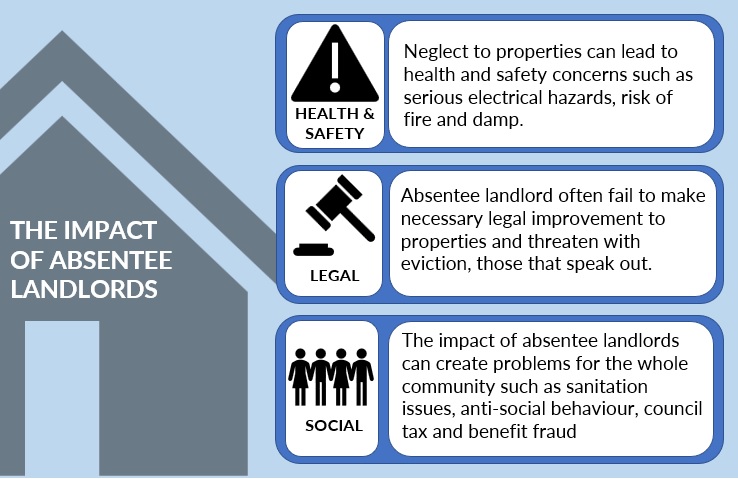Tracing Absentee Landlords: A rapid review of the evidence
Background
This work supported the broader ‘Neighbourhood Resilience Programme’ (NRP) developed by NIHR Collaboration for Leadership in Applied Health Research and Care for the North West Coast, Public Health Theme (https://neighbourhoodresilience.uk/). This programme recognised the importance of a systems level approach to enhancing neighbourhood resilience (as opposed to individual resilience), and as a way to improve the social determinants of health inequalities. The NRP was implemented between 2016 and 2019. It aimed to test a systems approach to enhancing collective community capacity for action on social and health inequalities. The NRP recognised a number of neighbourhoods with relatively poor health in the North West Coast footprint. This particular element of the NRP focused on absentee private sector landlords, and how local authorities can identify and trace them.
Absentee landlords purchase properties which are then managed through agents or property management organisations, sometimes meaning that the landlord is not easily contactable or even identifiable by tenants or local authorities. This is sometimes accompanied by a lack of accountability, and lack of civic motivation to contribute to the wellbeing of local communities through responsible property ownership and management. This means that such properties are often badly maintained and managed, and the areas in which they occur can become vulnerable to wider associated social problems, including crime, noise pollution and environmental degradation. This in turn can impact on the health of tenants and local communities (1)
Who is affected by the problem?
This work focused on people living in relatively disadvantaged neighbourhoods. The key inequality is thus socio-economic.
Who was involved in the research and how were they involved?
The need to address the issue of absentee landlords arose through consultations with local residents and local stakeholder organisations from neighbourhoods identified as part of the NRP, in particular the Claremont neighbourhood in Blackpool. Local residents in the neighbourhood initiated a local participatory enquiry or investigation, as they were keen to find ways of addressing the challenges facing their local community as a result of the high prevalence of absentee landlords, including poor quality housing experienced by tenants, anti-social behaviour, transient populations which undermined social cohesion and the need for a new bespoke local policy approach to the issue.
The participatory enquiry in Claremont was shaped by the Health Inequalities Assessment Toolkit (HIAT), which is an assessment process to ensure that CLAHRC NWC activities have the potential to contribute to reducing inequalities in health. Going through this process helped to refine the focus of the participatory enquiry. In particular, a shift in emphasis on the target population: from engaging in a conversation with letting agencies and housing associations about good practice to direct engagement and involvement with socio-economically vulnerable tenants through training on housing rights, drop in sessions in public spaces and a housing festival.
What did we do?
The work involved a Rapid Review of the literature around absentee and rogue landlords between 1990 and 2017. The review identified academic and grey literature through searches in Web of Science, institutional library catalogues, Google Scholar and generic Google searches.
What we found and what does this mean?
Very little academic literature was identified in the review. In addition, grey and policy literature was also scarce. From the available literature, a number of themes were identified including impacts of absentee landlordism on tenants and local communities, and methods of tracing and identifying absentee landlords. Impacts included on social, legal, and health and safety problems, with a range of associated issues impacting on health and wellbeing, including increased fire risk, overcrowding, poorer sanitation, electrical hazards, drug and alcohol use, and damp. The review also pulled together different approaches for identifying and tracing absentee landlords for tenants, organisations and local authorities to employ. These included statutory powers, national information registers, local authority records, and other databases.

Wider impact on health inequalities/health equity
The review identified broader and long-term implications of absenteeism on health inequalities for communities and tenants. This involves a cycle of cheaper housing in deprived areas, cheap purchase by unscrupulous landlords, and the subsequent contribution of absenteeism to the problems that underpin neighbourhood decline, and thus sustain the inequalities faced by new tenants who are often the most vulnerable (2).
The findings of the review have been used by residents and stakeholders in neighbourhoods identified under the NRP, to help tackle absentee landlords. Although no direct evidence is available as to the impact of these findings on neighbourhood health and wellbeing, by tackling such social determinants, health inequalities can be ameliorated further downstream.
What next?
The summary of literature will be used by residents and stakeholders to further develop resilience actions within their neighbourhoods to address local impacts resulting from absentee landlords.
This project was led by Glenn Simpson from the University of Liverpool and supported by the National Institute for Health Research Applied Research Collaboration North West Coast (NIHR ARC NWC). This case study was created by Dr. Neil Wilson, a Research Associate from the University of Central Lancashire and graphics were created by Paul Boland, MSc., a Research Assistant from the University of Central Lancashire and member of the MIDAS team (Evidence Synthesis) working in collaboration with the project lead.
References
1. Shelter. What works? Tackling rogue landlords and improving the private rented sector. 2013 [Accessed: 20 March 2017]. Available from: https://england.shelter.org.uk/__data/assets/pdf_file/0003/703740/Emerging_Good_Practice_Report_v2.pdf.
2. Davies BaT, A. Back to Rising Damp? Addressing housing quality in the private rented sector. 2014 [Accessed: 20 March 2017]. Available from: http://www.ippr.org/files/images/media/files/publication/2014/01/back-to-rising-damp_PRS_Jan2014_11767.pdf.